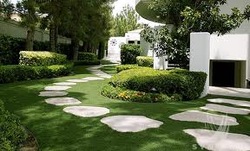|
Automated irrigation systems are common place for both commercial and residential properties. Although they are convenient and efficient, and watering times can be adjusted with timers, these systems do not take into account daily fluctuations in rain. The last few years in Santa Fe the drought has felt severe, yet, this summer season we were blessed with regular rain that was appreciated by avid gardeners and trees alike!
Water sensors can be installed to monitor moisture levels, ensuring that your irrigation system does not activate when there is already sufficient soil moisture (aka a "rainy day"). These smart-system water sensors are a great choice for Santa Fe, where monsoons are unpredictable and water is a precious resource. Contact us today and one of our licensed irrigation technicians can discuss with you how implementing a water sensor at your home or business can save you water and money.
1 Comment
 Synthetic Lawn Synthetic Lawn For large commercial properties, water costs can be a large part of the budget, particularly in the late spring, summer and early fall. It is important to review your water usage through a thorough irrigation audit, as well as assess the current type of landscaping. A water-efficient, sustainable landscape can reduce water use by 25-55%. - Place plants with similar water needs together for more efficient use of water - Use plants that are native to the region. Once they are established, they will require little to no water. - Apply a ground cover over planter beds, such as gravel or mulch to help retain water and help prevent water-consuming weeds from cropping up. - Convert turf areas to synthetic lawn or gravel, or choose a grass type that requires less water. Buffalo or Bermuda grass need 20% less water than other species. |
ArchivesCategories
All
Aspen Trees
Best Vines For Santa Fe
Cacti
Commercial Landscaping
Commercial Properties
Diy
Drought Tolerant Plants
Flowering Vines
Flowers
Flowers For Santa Fe
Flowers In New Mexico
Gravel
Hardscaping
Home Plant Decor
Irrigation
Landscaping Tips
Perennials
Ph Testing
Residential Landscaping
Rock Garden
Santa Fe Landscaping
Soil Testing
Solar Lighting
Spring
Succulents
Sustainable Landscaping
Tent Caterpillars
Vines
Water Saving Tips
Water Sensor
Xeric
Yucca
|

